Prompted by Aled Scourfield, BBC Wales reporter for West Wales who read a previous post and interviewed me last Friday for the evening news, I decided I better get on and do what I promised to do and try and look at the rural distancing effect a bit more. Geographical distancing may be a better phrase. What I was thinking about was what effect does population density have on the spread of an infectious organism in the Welsh community. I downloaded a copy of the daily data published by my colleagues in Public Health Wales on Friday 21st May.
I am not the only person thinking about the issue of people spacing. A recent Tweet from Nathaniel Barker (@NatBarkerIH) prompted a review of his article in Inside Housing. He was looking at the issue of overcrowding. This is different to my investigation yet is similar in that it relates to the numbers of people and their proximity one to another. And of course, his overcrowding in certain areas will be picked up in the figures I use below.
For my investigation, I downloaded the provisional mid-year estimates for 2019 via this link. Wikipedia provided county areas in square kilometres. The population and square kilometre per local authority were added to the downloaded spreadsheet and used to calculate the health board populations and areas. This enabled the calculation of the population per square kilometre as well as the population per kilometre (i.e. population divided by the square root of the square kilometre.)
For each parameter reviewed the columns were summed and the sum used to calculate the proportion contributed for each health board and local authority area. By multiplying the all Wales cumulative total on each day by the area proportion, the total for that day calculated was plotted alongside the daily observed cumulative total. The seven health board areas below compare cumulative total with the calculated totals based on people per kilometre. The complete spreadsheet is available to download and review here and includes graphs for each of the 22 local authorities alongside the calculations. There is also a sheet per health authority with the underlying local authority for each.

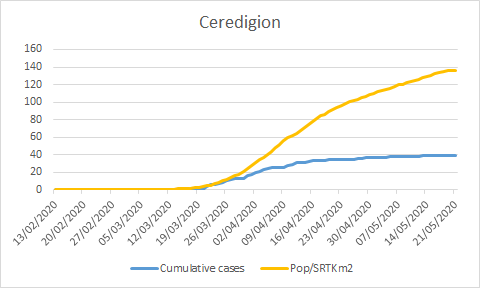
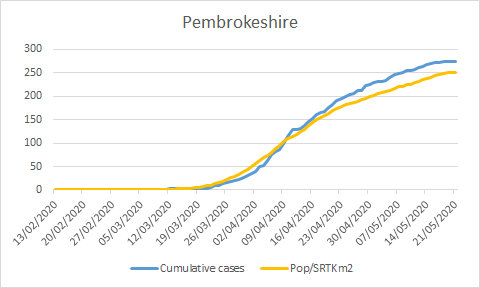
This post seeks to look at the effect of population density as a predictor for case numbers, as the article by Nathaniel Barker also highlights. The larger number of cases occur where there is an increase in population density. However, as discussed repeatedly in this blog, health is a complex adaptive system, with multiple factors competing to influence the system. While for Hywel Dda, Pembrokeshire calculated numbers approximate the observed numbers, Carmarthenshire exceeds the calculated while Ceredigion is considerably an overestimate compared to what is observed in practice.
But even this is interesting when considering the observation described previously of infections travelling from the east along the M4 corridor, arriving in Carmarthenshire first, moving to Pembrokeshire and then north to Ceredigion. Superimposed on the natural geographical spacing I was seeking to demonstrate is the lockdown effect. We in the west of Wales locked down with the rest of Wales and the UK but the virus arrived later with us and most latterly, in Ceredigion. Thus, what we may be seeing here is the variable effect of lockdown in the three counties at the time the virus arrived. The most dramatic effect being in Ceredigion.
The national graphs and tables have demonstrated the effect lockdown has had on reducing the epidemic curve from an acute peak to a flattened curve, due to the diligence of the population obeying the national rules. As this continues to worry people for the next phase, my next blog I hope will again look at transmission dynamics and what the future may hold for us.

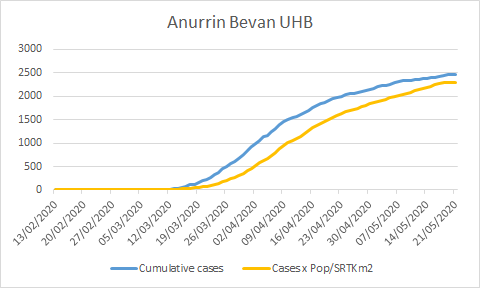


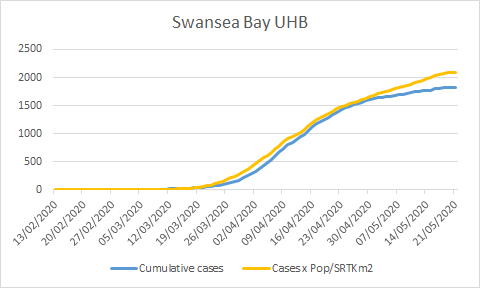
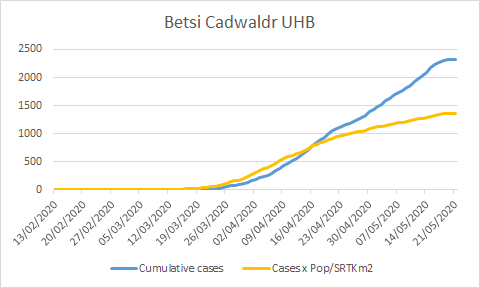
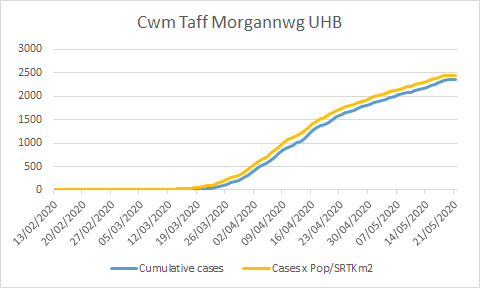
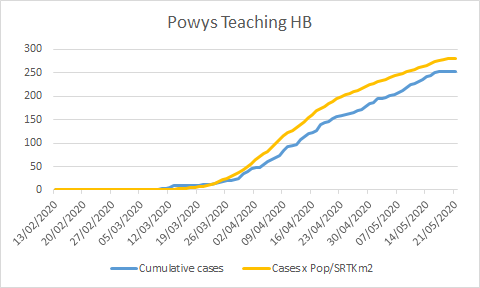
Good afternoon Mike,
Another fascinating article thank you. I was wondering what your thoughts were at this time regarding the length of time the virus has been in the UK and in Wales. I wrote something similar and had a chat with you on a previous article of yours, the ‘Covid 19 – where next’ and was just wondering what your thoughts were at this point.
It seems by now that the timeline is being pushed back all the time, particularly with the revelation in France that a person who suffered with pneumonia on the 27th of December, upon revisiting his samples, had tested positive for Coronavirus (i believe some lung x rays even further back than this are now being looked at as well as they look similar to covid lung cases). Similar instances have happened in the USA with the first deaths with no history of travel on February the 6th in California I believe, so if it was community transmission the timeline from the death on Feb 6th can be pushed back quite a bit possibly.
Also this article from Reuters shows that Italian scientists are investigating if the higher than usual number of cases of severe pneumonia and flu in Lombardy in the last quarter of 2019 was anything to do with Corona. Leo Varadkar the Irish Taoiseach has also commented that its very possible that the virus may have reached Ireland by at least December of 2019, which for a PM and former physician is quite a statement.
https://www.reuters.com/article/us-health-coronavirus-italy-timing-idUSKBN21D2IG
Out of curiosity I decided to look at ONS data on death number in Wales (very morbid I know) to see if anything jumped out. What was interesting (and would be more than happy for someone to double check and correct me if wrong), is that for 2019 the total deaths in Wales was 33182, which was the 4th highest total in the years between 2012 and 2019. However when looking at specifically October, November, December the total for 2019 was 8807 – which was the highest total by 367 in the years between 2012 and 2019. So although for the full year 2019 was the 4th highest overall, the end of last year was the highest. There may be nothing in this at all but still thought it interesting.
If you add in January 2020 (i.e. October/November/December/January) then 2019/2020 again was the highest (by 112 deaths) in the years between 2012 and 2019. Adding in February took 2019/2020 down to second place in terms of deaths behind 2017/2018 which I believe was a bad flu year? Was this year a bad flu year as well?
When I looked at county breakdowns (I’m not sure if you can take anything from it), however there were unusual spikes in places such as Conwy, Flintshire, Denbighshire, Gwynedd (Anglesey to a lesser extent), Bridgend, Vale, RCT, during October of last year – Monmouthshire and Powys during November and Pembrokeshire, NPT and Carmarthenshire during December. This wasn’t replicated for all counties however but from what I see, from September last year to the end of the year the deaths in Wales as a whole were above the 5 year average by some margin.
Of course I’m not suggesting these are all Covid deaths, or indeed that they are any covid deaths but just thought it interesting considering the timeline constantly being pushed back. Also its interesting that the areas seeing spikes e.g. in December Carmarthenshire, NPT and Pembrokeshire are neighbouring – in November Powys and Monmouthshire are neighbours and in October (bar Bridgend, RCT and Vale which neighbour each other) that much of North Wales saw a spike which almost seems as something was passing through which could have been anything e.g flu i accept
It would be interesting for example, in places like Conwy or Denbighshire that if medical professionals noted any increase in those with respiratory issues, or what we now know as COVID symptoms towards the end of last year in places such as Ysbyty Glan Clwyd or Ysbyty Gwynedd – are there any samples that can be checked back and tested or possibilities for retrospective studies etc.
I don’t know how this looks on an UK wide basis, an England only basis or Scotland only basis but just thought that some of the results were rather interesting (but may very well be coincidental) and wondering what your thoughts were on it. I won’t be offended if its all dismissed as nonsense!!
I also was reading about the mysterious ‘vaping’ pneumonia that was circulating the USA during the middle and end of last year reported in the Washington Post many times, CNBC etc, which sounds suspiciously COVID like however I will have to trust the healthcare experts there that it was indeed vaping that was causing this and nothing else!
Thank you Mike
Many thanks, Sion.
The Chinese were certainly investigating their increase in respiratory infections in Wuhan before they reported to WHO at the end of December and there will have been travelers disbursing during this period. I also saw the French report but had not picked up on the Italian investigations or the Irish statements, which are fascinating and I certainly remain very interested in what went on in Lombardy. If the Italians find evidence, then that strengthens the case for it being in other European countries earlier than we anticipated.
From a Welsh perspective, My colleague, Dr Catherine Moore (@SmallRedOne) did run a number of stored samples from respiratory investigations submitted in December looking for the virus and were unsuccessful. That does not mean there was not of course. However, I would again reiterate that I continue to hold the view that this coronavirus will behave as other respiratory viruses with common set of symptoms and signs, which is why people who had severe symptoms before the virus appeared to arrive, would try to make the link back into December.
The ONS data will always go up in the winter months due to the excess winter deaths associated with severe respiratory disease, the ‘flu’ season; albeit many viruses not just Influenza. Every year when we start detecting Influenza viruses the labs investigate how well the match is with the current vaccine. There was a worry following the southern hemisphere Influenza season and particularly the Australian experience that the match may not be as good as would be liked. I have not seen any data for the UK match but that may offer an explanation for the apparent increase you noted in the ONS data.
The variation of deaths by county are always interesting but as I found with my investigations in preparing for this post, while there was a reasonable match when trying to use geographical distancing to predict at the health board level, I was less convinced by the local authority match. If you want to see all these graphs, you would have to take a look at the Excel spreadsheet available to download from the link in the main body of the post.
Thanks again for sharing your thoughts and investigations.
Good afternoon Mike,
Thank you very much for taking the time to reply. Yes any Italian/Lombardy investigations will be fascinating to watch unfold and I’m sure that between that and more French analysis we will have a clearer picture in time. From past cases they looked at in Paris I think it was only 1 out of 24 samples tested that tested positive but with no apparent history of travel or contact in Paris it is still intriguing.
Very interesting to see that Dr Catherine Moore has done tests on samples from December, and the results are also interesting and also probably disappointing I guess in terms of gauging how far along the pandemic we are. Was that samples from all over Wales or from one particular area?
I thought I should just clarify that in terms of the ONS data i looked at, the spikes seen were placed against the five year averages so not just analysing 2019 on its own which is why it looked to stand out from past trends, i.e. there were small spikes in the 5 year average for ‘flu seasons’ but looking at somewhere like Conwy for example there were 47 more deaths in October 2019 than the 5 year average and 31 more than the nearest which was 2012 and so on. Not huge numbers of course but then we aren’t a huge country. I can’t share them here unfortunately
Also as you mention the issues with getting a match to the flu vaccine last year, was it a particularly harsh flu year in terms of death then? I did the analysis to Health Board level as well in case, as you note, that county level data can be less convincing. Every Health Board area had a higher than the 5 year average death total for the measurement of October/November/December as well as when adding January to the mix e.g. Betsi Cadwalader had 177 more deaths in (October/November/December/January) of 2019/2020 than the five year average, Hywel dda had 79 etc etc. Appreciate this could also be reflective of many other factors as well such as population ageing and so on.
May I also just ask your thoughts on the antibody tests and your thoughts on if people fight it off with different means? As well as all the discussions in the media and so on about it, I was talking to someone yesterday who became ill in March along with 3 relatives. The 3 relatives had tests at the time and were confirmed as being COVID positive, and he did not receive a test. He got an antibody test and received the result back from the lab as negative. For him to have the same illness symptoms at the same time as the relatives you’d highly expect it was COVID that he had, so is it bad tests? Different means of combating the virus?
I wrote to you on a previous blog about the illness i had last week of February that lasted until mid/late March and I almost went for an antibody test myself just for peace of mind either way but thought against it following seeing conflicting reports about their effectiveness and purpose.
Thank you
Thanks, Sion.
I do not have the level of detail over which samples were tested by my colleague from the December samples. During the winter season, the HDUHB based labs were doing urgent tests locally while more routine samples were sent to Cardiff. As well as being the main virology lab for Wales, Cardiff also have responsibility of local testing for Cardiff. Based on the data in this post, Cardiff has more positive samples than locally in HDUHB. Therefore, samples available to her in Cardiff would be more likely to give a positive result if present. As I say, not finding any positives does not mean there were none.
Until this year, my focus has not been viruses, as earlier blog posts will attest. I therefore have no memory in relation to the winter season. I suspect I will be maintaining a virus interest this winter! I therefore have not looked at the ONS or virus data for last winter.
I would agree with you, if 3 people in a family all tested positive and a 4th had similar symptoms, then I would assume the same virus would have been responsible. In a normal outbreak, once a cause for the outbreak has been determined, we tend to use a case definition, rather than having to rely on testing everyone. Tests may give negative results but if the epidemiology fitted the pattern of other cases, we would normally tend to count as a case.
In terms of antibody testing, I’m trying to write the next blog, which I hope will include some thoughts around such testing. As most people in the country will not have any evidence of meeting the virus (either PCR antigen testing or antibody testing.) The value of antibody testing may prove to be limited. In the past, the only role antibody testing has had after each winter and pandemic is in serum surveys to get non-personal epidemiological data. We normally do not have the level of anxiety over whether we have o have not met the virus. I think in time we may learn to trust the same clinical markers we have always used – once a person has got over the infection, they can move on with their lives, until the next time they meet a respiratory virus.
Thank you very much once again for replying Mike, haha I’m sure many will be taking an interest in virus season this winter!
The question of the official timeline, how many have been infected, antibodies and so on seems to be a fast moving one at present.
Fergus Walsh of the BBC posted an article in which he tested positive for antibodies in 3 separate tests, and noted that;
“So when was this? I’ve not had any symptoms in recent months. I’m rarely ill, but I did have a bout of pneumonia in early January. I was off sick for about 10 days and had a cough and a high temperature. I couldn’t shake it off. My GP in Windsor diagnosed a bacterial infection and gave me antibiotics. These helped a bit, but in late January I needed another course of antibiotics. These seem to have done the trick. Was it really Covid-19?
I don’t think so. The first confirmed case of coronavirus in the UK was in late January when two people from China fell ill in York. It wasn’t until a month later that the first cases of domestic transmission occurred. Note that although I’d been reporting on the outbreak in China by mid-January, the farthest afield I’d been in recent months was Christmas in Brussels”
He goes on to note that he had no symptoms of anything since his early January pneumonia, so although an assumption you would assume that this was his Covid19 infection. I asked if any blood was taken at the time and if they could check that to which I didn’t receive a reply. Its only the basis of the official timeline that he doubts that it was covid but it does seem strange even though a high percentage do seem to be asymptomatic?
He has since posted the following article;
https://www.bbc.co.uk/news/health-52935644
A very interesting read and one concerning thing that stood out to me from it was the following;
“Public Health England has been doing surveillance of the prevalence of Covid-19.
This includes analysing samples from blood donors across England, which are tested for the presence of coronavirus antibodies.
It found the antibodies were present in 1.5% of donor samples in London in the week of 23 March.
Given that it takes at least two weeks for antibodies to show up, that means those people got infected at least two weeks previously, in early March.
That is only a week or so after the first confirmed human to human transmission in the UK. Bear in mind that donors are advised to wait a couple of weeks after any sickness before giving blood, so it might have been even earlier – unless they were asymptomatic and never knew they had been infected with a virus.
Frustratingly, there are no plans to check donations made in February or January, which would give firmer evidence about the origins of Covid-19 in the UK. ”
That last sentence is rather concerning, why not check what have they got to lose? Additionally there was news two days ago about a woman who had been skiing in Austria over New Years and been ill afterwards testing positive for antibodies which seems to aid in pushing the timeline back further still as well as the woman described in Fergus Walsh’s article who was ill in late November and since tested positive in an antibody test.
Additionally, the reports released today by Harvard Medical School into hospitals in China and searches made into search engines by the public;
https://www.theguardian.com/world/2020/jun/09/coronavirus-may-have-been-in-wuhan-in-august-study-suggests
Although the study has its limitations (hospital car parks vary in busyness) it still is interesting (especially the symptom searching) as is the accounts of numerous athletes and teams who were present at the Wuhan Military Games in October, see mainly the Swedish and French athletes complaining of illness and strange behaviour. Here is one example from that;
https://www.mirror.co.uk/news/uk-news/french-army-returned-wuhan-military-21988912
Couple this with the “mysterious vaping illness” that was prevalent in the USA mid to late 2019 and the fact that Rosstat (the Russian statistics agency) noting that there were 37% more cases of pneumonia illnesses in Moscow in January of 2020 than 2019 and it gets a very confusing picture.
I did look on ONS for illnesses relating to, or put down as pneumonia, for last year but as of yet the data only goes up to 2018 unfortunately and won’t be released for some time.
I find myself trying not too think too much about it but it does make you wonder at times if things are being covered up or reported on truthfully and are we being told the full extent of things or is it simply just a fastly evolving picture.
Thank you Mike
Sion
Thanks, Sion.
The key to Fergus Walsh’s positive test may well be in his trip to Brussels. If you use the , on the table you can click on the headers. You will find that Belgium has the second highest number of deaths per million (second to the tiny San Marino – in the region on northern Italy) and has more cases per million than us in the UK. Given the previous discussion around demonstrable earlier virus in France, it strikes me that would be a good candidate.
I do not know how long blood donor serum is stored. There are other collections associated with specific functions e.g. pregnancy related while the mum is pregnant but from a general population perspective much more limited. I suspect teams will retrospectively take a look at what they have, when the heat has died down and more answers will then be forthcoming. These, of course, often end up leaving more questions!
Thanks Mike,
Yes it would seem so! As you mention Belgium has been affected badly and if he was there over Christmas and then became ill early January then it does make sense, and you then begin to wonder how many more instances like this are there; like the woman who was skiing in Austria then became ill early January before testing positive for antibodies; like the cases in France in December, like the high cases of pneumonia in Northern Italy late 2019.
As you have mentioned previously on this and other blogs, a great deal of people remembering their symptoms are associating their other winter illnesses with Covid (and I should probably place myself in that category having had all the symptoms late February to mid March – although timeline doesn’t seem so ridiculous anymore!) – but you do wonder if there are some of those who did actually have it, like the asthma Uk nurse i spoke to who commented that she and her son had a ‘very bad’ pneumonia in January.
If to make an assumption, it would seem to have been fairly steady in some parts of Europe late 2019 as there are more and more people coming out and saying they have been ill after being to Belgium, France, Italy, Austria etc in late 2019 which then makes you wonder when did it begin to get a foothold here in the UK.
Haha yes! If we ever did find out I’m sure some would be in for a shock regarding how long its been about!